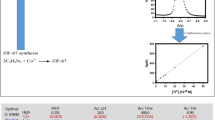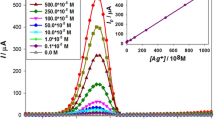Abstract
The synthesis and use of a suitable metal–organic framework (ZIF-67) as a sensory material for voltammetric measuring of silver(I) is the subject of this investigative work. In this regard, the size exclusion property of the ZIF-67 is coupled with the analytical voltammetry method and as a result, an efficient approach for measuring silver(I) has been obtained with appropriate selectivity and sensitivity. The detailed characterization of the synthesized ZIF-67 as well as the carbon paste electrode modified with it (Fourier transform-infrared spectroscopy, X-ray diffraction, transmission electron microscopy, scanning electron microscopy–energy-dispersive X-ray analysis, Brunauer–Emmett–Teller method, cyclic voltammetry, and impedance spectroscopy) indicates the exact synthesis of high-purity ZIF-67. Box–Behnken design has been used to optimize the conditions of preparation and operation of the sensor. There is a direct relationship between silver molarity in the enrichment solution and silver strip** current in the 1.0 × 10−10 to 2.5 × 10−7 molarity range. The detection limit was 2.5 × 10−11 M. Proper selectivity of this sensor greatly reduces mercury interference in silver measurement. When using the sensor to measure silver in real samples, results were obtained that agree with the results of the classical method of measuring silver.
Graphical abstract















Similar content being viewed by others
References
Chuang CH, Kung CW (2020) Metal–organic frameworks toward electrochemical sensors: challenges and opportunities. Electroanalysis 32:1885–1895
Anik Ü, Timur S, Dursun Z (2019) Metal organic frameworks in electrochemical and optical sensing platforms: a review. Microchim Acta. https://doi.org/10.1007/s00604-019-3321-0
Zhao Y (2016) Emerging applications of metal–organic frameworks and covalent organic frameworks. Chem Mater 28:8079–8081
Furukawa H, Cordova KE, O’Keeffe M, Yaghi OM (2013) The chemistry and applications of metal–organic frameworks. Science 341:1230444
Zhong G, Liu D, Zhang J (2018) The application of ZIF-67 and its derivatives: adsorption, separation, electrochemistry and catalysts. J Mater Chem A 6:1887–1899
Bhattacharjee S, Jang MS, Kwon HJ, Ahn WS (2014) Zeolitic imidazolate frameworks: synthesis, functionalization, and catalytic/adsorption applications. Catal Surv Asia 18:101–127
Arif D, Hussain Z, Sohail M, Liaqat MA, Khan MA, Noor T (2020) A non-enzymatic electrochemical sensor for glucose detection based on Ag@TiO2@ Metal–organic framework (ZIF-67) nanocomposite. Front Chem 8:573510
Tang J, Jiang S, Liu Y, Zheng S, Bai L, Guo J, Wang J (2018) Electrochemical determination of dopamine and uric acid using a glassy carbon electrode modified with a composite consisting of a Co(II)-based metal–organic framework (ZIF-67) and graphene oxide. Microchim Acta 185:486
Dong Y, Zheng J (2020) Tremella-like ZIF-67/rGO as electrode material for hydrogen peroxide and dopamine sensing applications. Sens Actuators B 311:127918
Zhang W, Fan S, Li X, Liu S, Duan D, Leng L, Cui C, Zhang Y, Qu L (2020) Electrochemical determination of lead(II) and copper(II) by using phytic acid and polypyrrole functionalized metal–organic frameworks. Microchim Acta 187:69
Zhang Y, Yu H, Liu T, Li W, Hao X, Lu Q, Liang X, Liu F, Liu F, Wang C, Yang C, Zhu H, Lu G (2020) Highly sensitive detection of Pb2+ and Cu2+ based on ZIF-67/MWCNT/Nafion-modified glassy carbon electrode. Anal Chim Acta 1124:166–175
Shi L, Li Y, Cai X, Zhao H, Lan M (2017) ZIF-67 derived cobalt-based nanomaterials for electrocatalysis and nonenzymatic detection of glucose: difference between the calcination atmosphere of nitrogen and air. J Electroanal Chem 799:512–518
Shi L, Cai X, Li H, He H, Zhao H, Lan M (2018) ZIF-67 derived porous carbon from calcination and acid etching process as an enzyme immobilization platform for glucose sensing. Electroanalysis 30:466–473
Bhattacharjee S, Lee YR, Ahn WS (2015) Post-synthesis functionalization of a zeolitic imidazolate structure ZIF-90: a study on removal of Hg(II) from water and epoxidation of alkenes. CrystEngComm 17:2575–2582
Švancara I, Vytřas K, Kalcher K, Walcarius A, Wang J (2009) Carbon paste electrodes in facts, numbers, and notes: a review on the occasion of the 50-years jubilee of carbon paste in electrochemistry and electroanalysis. Electroanalysis 21:7–28
Unala F, Kayab F (2020) Modelling of relation between synthesis parameters and average crystallite size of Yb2O3 nanoparticles using Box-Behnken design. Ceram Int 46:26800–26808
Salman M, Shahid M, Sahar T, Naheed S, Mahmood-ur-Rahman AM, Iqbal M, Nazir A (2020) Development of regression model for bacteriocin production from local isolate of Lactobacillus acidophilus MS1 using Box-Behnken design. Biocatal Agric Biotechnol 24:101542
Goo YT, Park SY, Chae BR, Yoon HY, Kim CH, Choi JY, Song SH, Choi YW (2020) Optimization of solid self-dispersing micelle for enhancing dissolution and oral bioavailability of valsartan using Box-Behnken design. Int J Pharm 585:119483
Khan A, Ali M, Ilyas A, Naik P, Vankelecom IFJ, Gilani MA, Bilad MR, Sajjad Z, Khan AL (2018) ZIF-67 filled PDMS mixed matrix membranes for recovery of ethanol via pervaporation. Sep Purif Technol 206:50–58
Zhou K, Mousavi B, Luo Z, Phatanasri S, Chaemchuen S, Verpoort F (2017) Characterization and properties of Zn/Co zeolitic imidazolate frameworks vs. ZIF-8 and ZIF-67. J Mater Chem A 5:952–957
Sotomayor FJ, Cychosz KA, Thommes M (2018) Characterization of micro/mesoporous materials by physisorption: concepts and case studies. Acc Mater Surf Res 3:34–50
Soumitra P, Challagulla S, Chakraborty C, Roy S (2019) A hydrogen evolution reaction induced unprecedentedly rapid electrocatalytic reduction of 4-nitrophenol over ZIF-67 compare to ZIF-8. J Electroanal Chem 853:113545
Lin KYA, Chang HA (2015) Ultra-high adsorption capacity of zeolitic imidazole framework-67 (ZIF-67) for removal of malachite green from water. Chemosphere 139:624–631
Wang Y, Hou P, Wang Z, Kang P (2017) Zinc imidazolate metal–organic frameworks (ZIF-8) for electrochemical reduction of CO2 to CO. ChemPhysChem 18:3142–3147
** Y, Ge C, Li X, Zhang M, Xu G, Li D (2018) A sensitive electrochemical sensor based on ZIF-8–acetylene black–chitosan nanocomposites for rutin detection. RSC Adv 8:32740–32746
Ma L, Zhang X, Ikram M, Ullah M, Wu H, Shi K (2020) Controllable synthesis of an intercalated ZIF-67/EG structure for the detection of ultratrace Cd2+, Cu2+, Hg2+ and Pb2+ ions. Chem Eng J 395:125216
Usov PM, McDonnell-Worth C, Zhou F, MacFarlane DR, D’Alessandro DM (2015) The electrochemical transformation of the zeolitic imidazolate framework ZIF-67 in aqueous electrolytes. Electrochim Acta 153:433–438
Miller JN, Miller JC (2010) Statistics and chemometrics for analytical chemistry, 6th edn. Pearson Education Limited, Harlow, p 117. ISBN 978-0-273-73042-2
Kielland J (1937) Individual activity coefficients of ions in aqueous solutions. J Am Chem Soc 59:1675–1678
Evtugyn GA, Stoikov II, Belyakova SV, Stoikova EE, Shamagsumova RV, Zhukov AY, Antipin IS, Budnikov HC (2008) Selectivity of solid-contact Ag potentiometric sensors based on thiacalix[4]arene derivatives. Talanta 76:441–447
Wang Y, Wu Y, **e J, Hu X (2013) Metal–organic framework modified carbon paste electrode for lead sensor. Sens Actuators B 177:1161–1166
Wang Y, Ge H, Wu Y, Ye G, Chen H, Hu X (2014) Construction of an electrochemical sensor based on amino-functionalized metal–organic frameworks for differential pulse anodic strip** voltammetric determination of lead. Talanta 129:100–105
Doménech A, García H, Doménech-Carbó MT, Llabrés-i-Xamena F (2006) Electrochemistry nanometric patterning of MOF particles: anisotropic metal electrodeposition in Cu/MOF. Electrochem Commun 8:1830–1834
Doménech A, García H, Doménech-Carbó MT, Llabrés-i-Xamena F (2007) Electrochemistry of metal–organic frameworks: a description from the voltammetry of microparticles approach. J Phys Chem C 111:13701–13711
Xu K, Pérez-Ràfols C, Cuartero M, Crespo GA (2021) Electrochemical detection of trace silver. Electrochim Acta 74:137929
Fu L, Wang A, **e K, Zhu J, Chen F, Wang H, Zhang H, Su W, Wang Z, Zhou C, Ruan S (2020) Electrochemical detection of silver ions by using sulfur quantum dots modified gold electrode. Sens Actuators B 304:127390
Xu K, Crespo GA, Cuartero M (2020) Subnanomolar detection of ions using thin voltammetric membranes with reduced exchange capacity. Sens Actuators B 321:128453
Vidal JC, Torrero D, Menes S, de La Fuente A, Castillo JR (2020) Voltammetric sensing of silver nanoparticles on electrodes modified with selective ligands by using covalent and electropolymerization procedures. Discrimination between silver(I) and metallic silver. Microchim Acta 187:183
Liu Q, Li J, Yang W, Zhang X, Zhang C, Labbe C, Portier X, Liu F, Yao J, Liu B (2020) Simultaneous detection of trace Ag(I) and Cu(II) ions using homoepitaxially grown GaN micropillar electrode. Anal Chim Acta 1100:22–30
Kolpakova N, Sabitova Z, Sachkov V, Medvedev R, Nefedov R, Orlov V (2019) Determination of Au(III) and Ag(I) in carbonaceous shales and pyrites by strip** voltammetry. Minerals 9:78
Hernández D, Cepriá G, Laborda F, Castillo JR (2019) Detection and determination of released ions in the presence of nanoparticles: selectivity or strategy? Electroanalysis 31:405–410
Shang H, Xu H, ** L, Chen C, Song T, Wang C, Du Y (2019) Electrochemical–photoelectrochemical dual-mode sensing platform based on advanced Cu9S8/polypyrrole/ZIF-67 heterojunction nanohybrid for the robust and selective detection of hydrogen sulfide. Sens Actuators B 301:127060
Hashemi F, Zanganeh AR, Naeimi F, Tayebani M (2021) Construction of a Tl(I) voltammetric sensor based on ZIF-67 nanocrystals: optimization of operational conditions via response surface design. Anal Bioanal Chem 413:5215–5226
Author information
Authors and Affiliations
Corresponding author
Ethics declarations
Conflict of interest
The authors declare that they have no conflict of interest.
Additional information
Publisher's Note
Springer Nature remains neutral with regard to jurisdictional claims in published maps and institutional affiliations.
Rights and permissions
About this article
Cite this article
Yaghoubi, M., Zanganeh, A.R., Mokhtarian, N. et al. ZIF-67 nanocrystals for determining silver: optimizing conditions by Box–Behnken design. J Appl Electrochem 52, 683–696 (2022). https://doi.org/10.1007/s10800-021-01660-z
Received:
Accepted:
Published:
Issue Date:
DOI: https://doi.org/10.1007/s10800-021-01660-z




